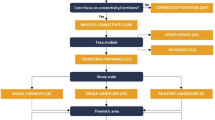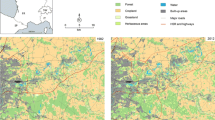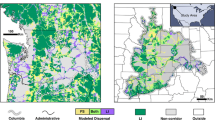Abstract
Context
Identifying animals movement through the landscape and delineating key corridors is critical for effective management and conservation. Still, assessments of space-use patterns and landscape connectivity are subjected to many limitations, especially in large scales.
Objectives
The main objective of this study was to assess functional connectivity for four focal mammal species with varying dispersal abilities and diets, across protected areas in a transnational region where only scarce information on movement patterns exists.
Methods
We used models relying on circuit theory, multiple layers of spatial information and graph-theoretical analysis. We delineated potential pathways suitable for species movement and evaluated connectivity status of the protected areas network in the Balkan Peninsula, southeastern Europe. Models were parameterized by combining information from experts and scientific literature, or by applying allometric equations, while novel connectivity metrics were developed.
Results
We identified four key, suitable corridors within the transnational study region. The largest one crossed three countries, highlighting the need for international conservation efforts. For species with higher dispersal abilities, the network of protected areas appeared to be well connected and robust while for others it consisted of numerous isolated sites, raising the need for species-specific management plans.
Conclusions
Our study serves as an example of how to set monitoring and conservation priorities in data-poor regions. Our findings highlight the need to identify a number of ecological corridors that could facilitate movement of multiple species with different functional traits and habitat preferences. This information is proved to be critical for setting spatially explicit conservation plans at local, regional and transnational scales.





Similar content being viewed by others
References
Abrahms B, Sawyer SC, Jordan NR, McNutt JW, Wilson AM, Brashares JS (2017) Does wildlife resource selection accurately inform corridor conservation? J Appl Ecol 54:412–422
Adriaensen F, Chardon J, De Blust G, Swinnen E, Villalba S, Gulinck H, Matthysen E (2003) The application of ‘least-cost’modelling as a functional landscape model. Landsc Urban Plan 64:233–247
Almpanidou V, Mazaris AD, Mertzanis Y, Avraam I, Antoniou I, Pantis JD, Sgardelis SP (2014) Providing insights on habitat connectivity for male brown bears: a combination of habitat suitability and landscape graph-based models. Ecol Model 286:37–44
Amano T, Sutherland WJ (2013) Four barriers to the global understanding of biodiversity conservation: wealth, language, geographical location and security. Proc R Soc B 280:20122649
Baguette M, Blanchet S, Legrand D, Stevens VM, Turlure C (2013) Individual dispersal, landscape connectivity and ecological networks. Biol Rev 88:310–326
Bănărescu PM (2004) Distribution pattern of the aquatic fauna of the Balkan Peninsula. In: Balkan biodiversity. Springer, pp 203–217
Benítez-López A, Alkemade R, Verweij PA (2010) The impacts of roads and other infrastructure on mammal and bird populations: a meta-analysis. Biol Conserv 143:1307–1316
Boitani L, Phillips M, Jhala Y (2018) Canis lupus. The IUCN Red List of Threatened Species 2018: e. T3746A119623865
Brodie J, Post E, Laurance WF (2012) Climate change and tropical biodiversity: a new focus. Trends Ecol Evol 27:145–150
Brodie JF, Giordano AJ, Dickson B, Hebblewhite M, Bernand H, Mohd-Azlan J, Anderson J, Ambu L (2015) Evaluating multispecies landscape connectivity in a threatened tropical mammal community. Conserv Biol 29:122–132
Christie MR, Knowles LL (2015) Habitat corridors facilitate genetic resilience irrespective of species dispersal abilities or population sizes. Evol Appl 8:454–463
Cooke SJ, Hinch SG, Wikelski M, Andrews RD, Kuchel LJ, Wolcott TG, Butler PJ (2004) Biotelemetry: a mechanistic approach to ecology. Trends Ecol Evol 19:334–343
Correa Ayram CA, Mendoza ME, Etter A, Salicrup DRP (2016) Habitat connectivity in biodiversity conservation: a review of recent studies and applications. Prog Phys Geogr 40:7–37
Cushman SA, McRae B, Adriaensen F, Beier P, Shirley M, Zeller K (2013) Biological corridors and connectivity. In: Macdonald DW, Willis KJ (eds) Key topics in conservation biology, vol 2. Wiley-Blackwell. Hoboken, NJ, pp 384–404
Dickson BG, Albano CM, Anantharaman R, Beier P, Fargione J, Graves TA, Gray ME, Hall KR, Lawler JJ, Leonard PB, Littlefield CE, McClure ML, Novembre J, Schloss CA, Schumaker NH, Shah VB, Theobald DM (2019) Circuit-theory applications to connectivity science and conservation. Conserv Biol 33:239–249
Dilkina B, Houtman R, Gomes CP, Montgomery CA, McKelvey KS, Kendrall K, Graves TA, Bernstein R, Schwartz MK (2017) Trade-offs and efficiencies in optimal budget-constrained multispecies corridor networks. Conserv Biol 31:192–202
Etherington TR (2016) Least-cost modelling and landscape ecology: concepts, applications, and opportunities. Curr Landsc Ecol Rep 1:40–53
Etherington TR, Holland EP (2013) Least-cost path length versus accumulated-cost as connectivity measures. Landsc Ecol 28:1223–1229
European Environment Agency - EEA (2012) Copernicus Land Monitoring Service, CORINE Land Cover (CLC, Version 20). Available at: https://land.copernicus.eu/pan-european/corine-land-cover/clc-2012. Accessed 20 January 2018
European Environment Agency - EEA (2016) Copernicus Land Monitoring Service, European Digital Elevation Model (EU-DEM, Version 1.1). Available at: http://land.copernicus.eu/pan-european/satellite-derived-products/eu-dem. Accessed 20 January 2018
Fahrig L (2003) Effects of habitat fragmentation on biodiversity. Annu Rev Ecol Evol Syst 34:487–515
Haddad NM, Brudvig LA, Clobert J, Davies KF, Gonzalez A, Holt RD, Lovejoy TE, Sexton JO, Austin MP, Collins CD, Cook WM, Damschen EI, Ewers RM, Foster BL, Jenkins CN, King AJ, Laurance WF, Levey DJ, Margules CR, Melbourne BA, Nicholls AO, Orrock JL, Song D, Townshend JR (2015) Habitat fragmentation and its lasting impact on Earth’s ecosystems. Sci Adv 1:e1500052
Hagen M, Kissling WD, Rasmussen C, De Aguiar MAM, Brown LE, Carstensen DW, Alves-Dos-Santos I, Dupont YL, Edwards FK, Genini J, Guimaraes Jn PR, Jenkins GB, Jordano P, Kaiser-Bunbury CN, Ledger ME, Maia KP, Darcie Marquitti FM, Mclaughlin O, Morrellato LC, O’Gorman EJ, Trojelsgaard K, Tylianakis JM, Vidal MM, Woodward G, Olesen JM (2012) Biodiversity, species interactions and ecological networks in a fragmented world. In: Advances in ecological research, vol 46. Elsevier, pp 89–210
Hebblewhite M, Haydon DT (2010) Distinguishing technology from biology: a critical review of the use of GPS telemetry data in ecology. Philos Trans R Soc B 365:2303–2312
Hoffmann M, Sillero-Zubiri C (2016) Vulpes vulpes. The IUCN Red List of Threatened Species. 2016: e. T23062A46190249
Jaeger JA (2000) Landscape division, splitting index, and effective mesh size: new measures of landscape fragmentation. Landsc Ecol 15:115–130
Jones KE, Bielby J, Cardillo M, Fritz SA, O’Dell J, Orme CL, Safi K, Sechrest W, Boakes EH, Carbone C, Connolly C, Cutts MJ, Foster JK, Grenyer R, Habib M, Plaster CA, Price SA, Rigby EA, Rist J, Teacher A, Bininda-Emonds ORP, Gittleman JL, Mace GM, Purvis A (2009) PanTHERIA: a species-level database of life history, ecology, and geography of extant and recently extinct mammals. Ecol Arch Ecol 90:2648–2648
Joppa LN, Pfaff A (2009) High and far: biases in the location of protected areas. PLoS ONE 4:e8273
Lovari S, Herrero J, Masseti M, Ambarli H, Lorenzini R, Giannatos G (2016) Capreolus capreolus. The IUCN Red List of Threatened Species 2016: e.T42395A22161386
Marrotte RR, Bowman J (2017) The relationship between least-cost and resistance distance PloS one 12:e0174212
Mazaris AD, Papanikolaou AD, Barbet-Massin M, Kallimanis AS, Jiguet F, Schmeller DS, Pantis JD (2013) Evaluating the connectivity of a protected areas’ network under the prism of global change: the efficiency of the European Natura 2000 network for four birds of prey. PLoS ONE 8:59640
McIntosh EJ, Pressey RL, Lloyd S, Smith RJ, Grenyer R (2017) The impact of systematic conservation planning. Annu Rev Environ Resour 42:677–697
McLellan B, Proctor M, Huber D, Michel S (2017) Ursus arctos (amended version of 2017 assessment). The IUCN Red List of Threatened Species 2017: e. T41688A121229971
McRae BH (2006) Isolation by resistance. Evolution 60:1551–1561
McRae BH, Dickson BG, Keitt TH, Shah VB (2008) Using circuit theory to model connectivity in ecology, evolution, and conservation. Ecology 89:2712–2724
Mimet A, Clauzel C, Foltête J-C (2016) Locating wildlife crossings for multispecies connectivity across linear infrastructures. Landsc Ecol 31:1955–1973
Nathan R, Getz WM, Revilla E, Holyoak M, Kadmon R, Saltz D, Smouse PE (2008) A movement ecology paradigm for unifying organismal movement research. Proc Natl Acad Sci 105:19052–19059
Pe’er G, Tsianou MA, Franz KW, Matsinos YG, Mazaris AD, Storch D, Kopsova L, Verboom J, Baguette M, Stevens VM, Henle K (2014) Toward better application of minimum area requirements in conservation planning. Biol Conserv 170:92–102
Pelletier D, Clark M, Anderson MG, Rayfield B, Wulder MA, Cardille JA (2014) Applying circuit theory for corridor expansion and management at regional scales: tiling, pinch points, and omnidirectional connectivity. PLoS ONE 9:e84135
Pimm SL, Raven P (2000) Biodiversity: extinction by numbers. Nature 403:843–845
Pinaud D, Claireau F, Leuchtmann M, Kerbiriou C (2018) Modelling landscape connectivity for greater horseshoe bat using an empirical quantification of resistance. J Appl Ecol 55:2600–2611
Radenković S, Schweiger O, Milić D, Harpke A, Vujić A (2017) Living on the edge: forecasting the trends in abundance and distribution of the largest hoverfly genus (Diptera: Syrphidae) on the Balkan Peninsula under future climate change. Biol Conserv 212:216–229
Richard Y, Armstrong DP (2010) Cost distance modelling of landscape connectivity and gap-crossing ability using radio-tracking data. J Appl Ecol 47:603–610
Riley SJ, DeGloria SD, Elliot R (1999) Index that quantifies topographic heterogeneity intermountain. J Sci 5:23–27
Roberge JM, Angelstam P (2004) Usefulness of the umbrella species concept as a conservation tool. Conserv Biol 18:76–85
Rondinini C, Di Marco M, Chiozza F, Santulli G, Baisero D, Visconti P, Hoffmann M, Schipper J, Stuart SN, Tognelli MF, Amori G, Falcucci A, Maiorano L, Boitani L (2011) Global habitat suitability models of terrestrial mammals. Philos Trans R Soc B 366:2633–2641
Sahraoui Y, Foltête J-C, Clauzel C (2017) A multi-species approach for assessing the impact of land-cover changes on landscape connectivity. Landsc Ecol 32:1819–1835
Santini L, Di Marco M, Visconti P, Baisero D, Boitani L, Rondinini C (2013) Ecological correlates of dispersal distance in terrestrial mammals. Hystrix 24:181–186
Santini L, Saura S, Rondinini C (2016) A composite network approach for assessing multi-species connectivity: an application to road defragmentation prioritisation. PLoS ONE 11:e0164794
Saura S, Bertzky B, Bastin L, Battistella L, Mandrici A, Dubois G (2018) Protected area connectivity: shortfalls in global targets and country-level priorities. Biol Conserv 219:53–67
Sawyer SC, Epps CW, Brashares JS (2011) Placing linkages among fragmented habitats: do least-cost models reflect how animals use landscapes? J Appl Ecol 48:668–678
Schiavina M, Freire S, MacManus K (2019): GHS population grid multitemporal (1975, 1990, 2000, 2015) R2019A. European Commission, Joint Research Centre (JRC). https://doi.org/10.2905/42e8be89-54ff-464e-be7b-bf9e64da5218 PID: http://data.europa.eu/89h/0c6b9751-a71f-4062-830b-43c9f432370f. Accessed 20 November 2019
Spear SF, Balkenhol N, Fortin MJ, McRae BH, Scribner K (2010) Use of resistance surfaces for landscape genetic studies: considerations for parameterization and analysis. Mol Ecol 19:3576–3591
Stevens VM, Verkenne C, Vandewoestijne S, Wesselingh RA, Baguette M (2006) Gene flow and functional connectivity in the natterjack toad. Mol Ecol 15:2333–2344
UNEP-WCMC, IUCN (2018) Protected Planet: The World Database on Protected Areas (WDPA). UNEP-WCMC and IUCN, Cambridge, UK, Available at: www.protectedplanet.net. Accessed 20 January 2018
UNEP-WCMC, IUCN, NGS (2018) Protected Planet Report 2018. UNEP-WCMC, IUCN and NGS. Cambridge, UK; Gland, Switzerland and Washington, DC, USA
van der Ree R, Smith DJ, Grilo C (2015) The ecological effects of linear infrastructure and traffic: challenges and opportunities of rapid global growth. In: Handbook of road ecology, pp 1–9
Webster MS, Marra PP, Haig SM, Bensch S, Holmes RT (2002) Links between worlds: unraveling migratory connectivity. Trends Ecol Evol 17:76–83
Weiss S, Ferrand N (2007) Phylogeography of southern European refugia. Springer, Berlin
Whitmee S, Orme CDL (2013) Predicting dispersal distance in mammals: a trait-based approach. J Anim Ecol 82:211–221
Zeller KA, McGarigal K, Cushman SA, Beier P, Vickers TW, Boyce WM (2017) Sensitivity of resource selection and connectivity models to landscape definition. Landsc Ecol 32:835–855
Zeller KA, McGarigal K, Whiteley AR (2012) Estimating landscape resistance to movement: a review. Landsc Ecol 27:777–797
Acknowledgements
The work of ADM was supported by Combine2Protect, a Project co-funded by the European Union and by National Funds of the Participating Countries under the IPA Cross-Border Programme “Greece – the Republic of North Macedonia 2014–2020. The views expressed in this publication do not necessarily reflect the views of the European Union, the participating countries and the Managing Authority. This research work was supported by the Hellenic Foundation for Research and Innovation (HFRI) under the HFRI PhD Fellowship grand (Fellowship Number: 1018). We would like to thank D. Bakaloudis, L. Georgiadis, D. Gioulatos, Μ. Hernando, G. Iliopoulos, Α. Karamanlidis, and G. Mertzanis for their assistance in background layer selection and evaluation.
Author information
Authors and Affiliations
Corresponding author
Additional information
Publisher's Note
Springer Nature remains neutral with regard to jurisdictional claims in published maps and institutional affiliations.
Electronic supplementary material
Below is the link to the electronic supplementary material.
Rights and permissions
About this article
Cite this article
Petsas, P., Tsavdaridou, A.I. & Mazaris, A.D. A multispecies approach for assessing landscape connectivity in data-poor regions. Landscape Ecol 35, 561–576 (2020). https://doi.org/10.1007/s10980-020-00981-2
Received:
Accepted:
Published:
Issue Date:
DOI: https://doi.org/10.1007/s10980-020-00981-2




